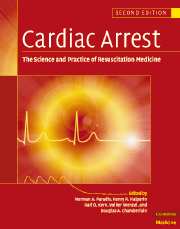Book contents
- Frontmatter
- Contents
- List of contributors
- Foreword
- Preface
- Part I Introduction
- Part II Basic science
- Part III The pathophysiology of global ischemia and reperfusion
- Part IV Therapy of sudden death
- Part V Postresuscitation disease and its care
- 47 Postresuscitation syndrome
- 48 Prevention and therapy of postresuscitation myocardial dysfunction
- 49 Prevention of postresuscitation neurologic dysfunction and injury by the use of therapeutic mild hypothermia
- 50 Postresuscitation neurologic prognostication and declaration of brain death
- 51 Bringing it all together: brain-oriented postresuscitation critical care
- Part VI Special resuscitation circumstances
- Part VII Special issues in resuscitation
- Index
51 - Bringing it all together: brain-oriented postresuscitation critical care
from Part V - Postresuscitation disease and its care
Published online by Cambridge University Press: 06 January 2010
- Frontmatter
- Contents
- List of contributors
- Foreword
- Preface
- Part I Introduction
- Part II Basic science
- Part III The pathophysiology of global ischemia and reperfusion
- Part IV Therapy of sudden death
- Part V Postresuscitation disease and its care
- 47 Postresuscitation syndrome
- 48 Prevention and therapy of postresuscitation myocardial dysfunction
- 49 Prevention of postresuscitation neurologic dysfunction and injury by the use of therapeutic mild hypothermia
- 50 Postresuscitation neurologic prognostication and declaration of brain death
- 51 Bringing it all together: brain-oriented postresuscitation critical care
- Part VI Special resuscitation circumstances
- Part VII Special issues in resuscitation
- Index
Summary
Multiple brain-damaging processes occur both during cardiac arrest and after return of spontaneous circulation (ROSC). The first aspect, the actual arrest, is best treated by rapid institution of artificial circulation/ventilation and early ROSC. The details and physiologic background for these procedures are discussed in previous chapters. This chapter will focus on the early period after restoration of spontaneous circulation and treatment aimed to prevent or minimize postischemic brain damage after restoration of spontaneous circulation. The ultimate importance of the postreperfusion (after ROSC) phase for long-term outcome is often underestimated. Currently it is believed that the majority of brain-injuring processes occur not during the no-flow state (cardiac arrest) but during resuscitative reperfusion. This latter stage includes a trickle-, a low-, and a temporary high-flow period. Since significant injury occurs during the resuscitation period, there is a window of opportunity to intervene and affect outcome. Nevertheless, the development of treatments for the multifactorial postresuscitation syndrome is complex and time-consuming and has thus far led to disappointing results. Numerous treatments effective in the laboratory have failed or been shown to have an almost undetectable benefit in clinical studies. Large multicenter studies – the only way to detect small(er) benefits – are extremely expensive and time-consuming and require an enormous administrative and financial investment. Sometimes ethical concerns about obtaining informed consent make clinical resuscitation research increasingly difficult. Nevertheless, definitive clinical studies are the only way to prove the effectiveness of resuscitation and postresuscitation treatment; clinically relevant laboratory studies may only help to select those that are most promising.
- Type
- Chapter
- Information
- Cardiac ArrestThe Science and Practice of Resuscitation Medicine, pp. 902 - 918Publisher: Cambridge University PressPrint publication year: 2007

